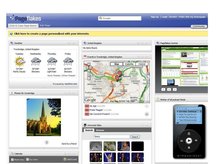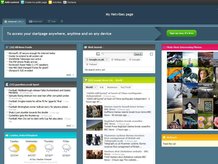For example, it requires a lot of code to embed a single RSS block in a web page, although there are off-the-shelf scripts that can help facilitate this and even some online services that generate the layout code for you.
JavaScript RSS Block Viewer generates cut-and- paste code you can plug into any site – static or dynamic. All you have to do is provide the RSS feed and choose a colour scheme.
If you need more control then MagpieRSS is a server side PHP script that parses RSS feeds.
Once the script is installed, you can add specific feeds to a page with as few as two lines – though it gets much more complex if you want to style headlines, titles and links separately or filter a feed using specific parameters.
Looking beyond the Google heartland
While these solutions simplify the task of adding RSS blocks to a page for a code-savvy developer, neither compares with the ease of adding bespoke blocks to a page in Netvibes or Protopage.
In addition, the current crop of start pages have features that your Heath Robinson version may struggle to compete with. Most services enable alternate layouts to be used and custom skins that change the look and feel of the page.
Get daily insight, inspiration and deals in your inbox
Sign up for breaking news, reviews, opinion, top tech deals, and more.
Netvibes, iGoogle and Pageflakes provide themes that let you change the overall look of the layout. You can also almost universally change the position of content blocks in your bespoke start page and create multiple, tabbed pages to organise different types of content.
For example, you could have a default front page full of news feeds, with tabs that take you to a page full of handy gadgets or blog content. Start pages help you get more from your web browsing by bringing together the information you access most often into one place.
The only drawback is that your choice might make content so easy to find that you’ll spend even more time online.
The best start pages on the web

Pageflakes - This site wins the award for getting your web experience personalised in the fastest time. You just make a few category selections and a page is created from scratch.
Slick and great looking, it’s not quite as clever as you might hope, though. While your approximate location is estimated from your IP address and used to set a weather widget – the default news feeds are always from CNN and USA Today.
There’s a lack of RSS search tools too. Create a free account and you can soon customise the site’s defaults to suit your own preferences. Of the tools we’ve reviewed, Pageflakes has the fanciest features for browsing content.
Widgets and feeds are called ‘Flakes’ here and you can browse for them in a window that pops up in the main page. As well as private start pages, you can also make ‘Pagecasts’. These are public versions of your private start page.
There are an impressive number of themes and layouts too. Our favourite feature though is PageFlake’s built-in feed reader – a tool that behaves like a desktop RSS client.

Netvibes - After a swift sign-up, Netvibes’ distinctly Web 2.0 style layout is yours to populate and customise.
Three starter tabs offer up news feeds, access to social networks, webmail and some online games. Just a dozen alternate themes are provided – alongside custom headings called ‘wallpaper’.We found that selecting some of these effectively hides the service’s navigation tools, though.
There’s an impressive selection of feeds, site gateways and applications that can be added to any page. RSS feeds can be added as direct URLs. Widgets are created using Netvibes’ own Ecosystem platform, an XML-based framework for building mini-applications. Most users will find everything they’ll need is offered by Netvibes from the start.